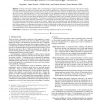627 search results - page 82 / 126 » Structural Learning of Activities from Sparse Datasets |
BIBM
2008
IEEE
14 years 3 months ago
2008
IEEE
Protein fold recognition is the prediction of protein’s tertiary structure (Fold) given the protein’s sequence without relying on sequence similarity. Using machine learning t...
JMLR
2010
13 years 3 months ago
2010
Inducing a grammar from text has proven to be a notoriously challenging learning task despite decades of research. The primary reason for its difficulty is that in order to induce...
ICASSP
2007
IEEE
14 years 3 months ago
2007
IEEE
Protein structure prediction aims to determine the three-dimensional structure of proteins form their amino acid sequences. When a protein does not have similarity (homology) to a...
HUMO
2007
Springer
14 years 3 months ago
2007
Springer
We present a method to simultaneously estimate 3d body pose and action categories from monocular video sequences. Our approach learns a lowdimensional embedding of the pose manifol...
VIS
2009
IEEE
14 years 10 months ago
2009
IEEE
Confocal microscopy is widely used in neurobiology for studying the three-dimensional structure of the nervous system. Confocal image data are often multi-channel, with each channe...

